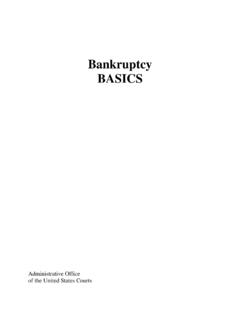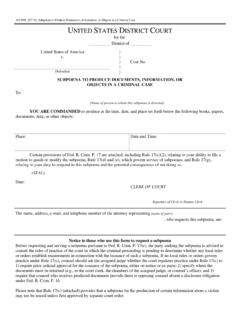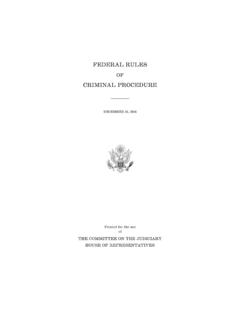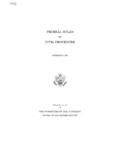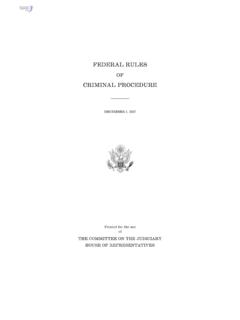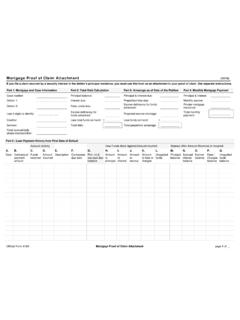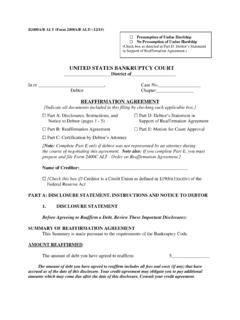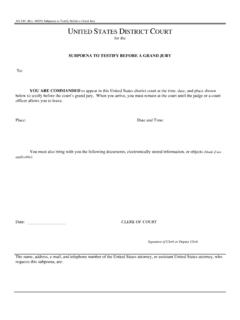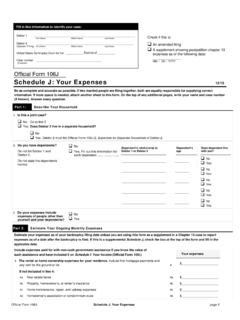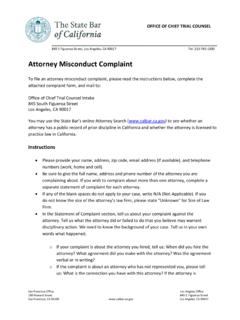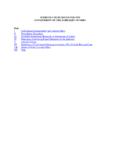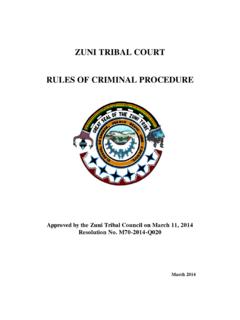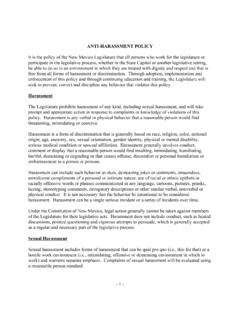Transcription of Guide to Judiciary Policy
1 Guide to Judiciary Policy Vol. 2: Ethics and Judicial Conduct Pt. E: Judicial Conduct and Disability Act and Related Materials Ch. 3: Rules for Judicial-Conduct and Judicial-Disability Proceedings 310 Overview 320 Rules for Judicial-Conduct and Judicial-Disability Proceedings Preface ARTICLE I. GENERAL PROVISIONS. 1. Scope 2. Effect and Construction 3. Definitions 4. Covered Judges ARTICLE II. INITIATION OF COMPLAINT. 5. Identification of Complaint 6. Filing of Complaint 7. Where to Initiate Complaint 8. Action by Circuit Clerk 9. Time for Filing or Identifying Complaint 10. Abuse of Complaint Procedure ARTICLE III. REVIEW OF COMPLAINT BY CHIEF JUDGE. 11. Chief Judge's Review ARTICLE IV. INVESTIGATION AND REPORT BY SPECIAL COMMITTEE. 12.
2 Special Committee's Composition 13. Conduct of Special-Committee Investigation 14. Conduct of Special-Committee Hearings 15. Subject Judge's Rights 16. Complainant's Rights in Investigation 17. Special-Committee Report ARTICLE V. REVIEW BY JUDICIAL COUNCIL. 18. Petition for Review of Chief-Judge Disposition Under Rule 11(c), (d), or (e). 19. Judicial-Council Disposition of Petition for Review 20. Judicial-Council Action Following Appointment of Special Committee Last revised (Transmittal 02-027) May 4, 2016. Guide to Judiciary Policy , Vol. 2E, Ch. 3 Page 2. ARTICLE VI. REVIEW BY COMMITTEE ON JUDICIAL CONDUCT AND. DISABILITY. 21. Committee on Judicial Conduct and Disability 22. Procedures for Review ARTICLE VII. MISCELLANEOUS RULES. 23.
3 Confidentiality 24. Public Availability of Decisions 25. Disqualification 26. Transfer to Another Judicial Council 27. Withdrawal of Complaint or Petition for Review 28. Availability of Rules and Forms 29. Effective Date Appendix to the Rules: Form AO 310 (Complaint of Judicial Misconduct or Disability). 310 Overview Section 320 of this chapter reproduces the Rules for Judicial-Conduct and Judicial-Disability Proceedings. They were adopted on March 11, 2008, and took effect on April 10, 2008. They were amended on September 17, 2015, and published in final form in May 2016. 320 Rules for Judicial-Conduct and Judicial-Disability Proceedings Preface These Rules were promulgated by the Judicial Conference of the United States, after public comment, pursuant to 28 331 and 358, to establish standards and procedures for addressing complaints filed by complainants or identified by chief judges under the Judicial Conduct and Disability Act, 28 351 364.
4 ARTICLE I. GENERAL PROVISIONS. 1. Scope These Rules govern proceedings under the Judicial Conduct and Disability Act (the Act), 28 351 364, to determine whether a covered judge has engaged in conduct prejudicial to the effective and expeditious administration of Guide to Judiciary Policy , Vol. 2E, Ch. 3 Page 3. the business of the courts or is unable to discharge the duties of office because of mental or physical disability. COMMENTARY ON RULE 1. In September 2006, the Judicial Conduct and Disability Act Study Committee ( Breyer Committee ), appointed in 2004 by Chief Justice Rehnquist, presented a report ( Breyer Committee Report ), 239 116 (Sept. 2006), to Chief Justice Roberts that evaluated implementation of the Judicial Conduct and Disability Act of 1980, 28 351 364.
5 The Breyer Committee had been formed in response to criticism from the public and Congress regarding the effectiveness of the Act's implementation. The Executive Committee of the Judicial Conference directed its Committee on Judicial Conduct and Disability to consider the Breyer Committee's recommendations and to report on their implementation to the Conference. The Breyer Committee found that it could not evaluate implementation of the Act without establishing interpretive standards, Breyer Committee Report, 239 at 132, and that a major problem faced by chief judges in implementing the Act was the lack of authoritative interpretive standards. Id. at 212 15. The Breyer Committee then established standards to Guide its evaluation, some of which were new formulations and some of which were taken from the Illustrative Rules Governing complaints of Judicial Misconduct and Disability, discussed below.
6 The principal standards used by the Breyer Committee are in Appendix E of its Report. Id. at 238. Based on the Breyer Committee's findings, the Committee on Judicial Conduct and Disability concluded that there was a need for the Judicial Conference to exercise its power under Section 358 of the Act to fashion standards guiding the various officers and bodies that must exercise responsibility under the Act. To that end, the Committee on Judicial Conduct and Disability proposed rules that were based largely on Appendix E of the Breyer Committee Report and the Illustrative Rules. The Illustrative Rules were originally prepared in 1986 by the Special Committee of the Conference of Chief Judges of the United States Courts of Appeals, and were subsequently revised and amended, most recently in 2000, by the predecessor to the Committee on Judicial Conduct and Disability.
7 The Illustrative Rules were adopted, with minor variations, by circuit judicial councils, to govern complaints under the Judicial Conduct and Disability Act. After being submitted for public comment pursuant to 28 358(c), the Judicial Conference promulgated the present Rules on March 11, 2008. They were amended on September 17, 2015. 2. Effect and Construction (a) Generally. These Rules are mandatory; they supersede any conflicting judicial-council rules. Judicial councils may promulgate Guide to Judiciary Policy , Vol. 2E, Ch. 3 Page 4. additional rules to implement the Act as long as those rules do not conflict with these Rules. (b) Exception. A Rule will not apply if, when performing duties authorized by the Act, a chief judge, a special committee, a judicial council, the Committee on Judicial Conduct and Disability, or the Judicial Conference expressly finds that exceptional circumstances render application of that Rule in a particular proceeding manifestly unjust or contrary to the purposes of the Act or these Rules.
8 COMMENTARY ON RULE 2. Unlike the Illustrative Rules, these Rules provide mandatory and nationally uniform provisions governing the substantive and procedural aspects of misconduct and disability proceedings under the Act. The mandatory nature of these Rules is authorized by 28 358(a) and (c). Judicial councils retain the power to promulgate rules consistent with these Rules. For example, a local rule may authorize the electronic distribution of materials pursuant to Rule 8(b). Rule 2(b) recognizes that unforeseen and exceptional circumstances may call for a different approach in particular cases. 3. Definitions (a) Chief Judge. Chief judge means the chief judge of a United States court of appeals, of the United States Court of International Trade, or of the United States Court of Federal Claims.
9 (b) Circuit Clerk. Circuit clerk means a clerk of a United States court of appeals, the clerk of the United States Court of International Trade, the clerk of the United States Court of Federal Claims, or the circuit executive of the United States Court of Appeals for the Federal Circuit. (c) Complaint. A complaint is: (1) a document that, in accordance with Rule 6, is filed by any person in his or her individual capacity or on behalf of a professional organization; or (2) information from any source, other than a document described in (c)(1), that gives a chief judge probable cause to believe that a covered judge, as defined in Rule 4, has engaged in misconduct or may have a disability, whether or not the information is framed as or is intended to be an allegation of misconduct or disability.
10 Guide to Judiciary Policy , Vol. 2E, Ch. 3 Page 5. (d) Court of Appeals, District Court, and District Judge. Courts of appeals, district court, and district judge, where appropriate, include the United States Court of Federal Claims, the United States Court of International Trade, and the judges thereof. (e) Disability. Disability is a temporary or permanent impairment, physical or mental, rendering a judge unable to discharge the duties of the particular judicial office. Examples of disability include substance abuse, the inability to stay awake during court proceedings, or impairment of cognitive abilities that renders the judge unable to function effectively. (f) Judicial Council and Circuit. Judicial council and circuit, where appropriate, include any courts designated in 28 363.
